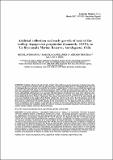Por favor, use este identificador para citar o enlazar a este item:
http://hdl.handle.net/10261/2404COMPARTIR / EXPORTAR:
 SHARE
BASE SHARE
BASE
|
|
| Visualizar otros formatos: MARC | Dublin Core | RDF | ORE | MODS | METS | DIDL | DATACITE | |

| Título: | Artificial collection and early growth of spat of the scallop Argopecten purpuratus (Lamarck, 1819), in La Rinconada Marine Reserve, Antofagasta, Chile |
Otros títulos: | Capacitación artificial y crecimiento temprano de la "semilla" de Argopecten purpuratus (Lamarck, 1819) en la reserva marina La Rinconada, Antofagasta, Chile | Autor: | Avendaño, Miguel; Cantillánez, Marcela; Thouzeau, Gérard; Peña, Juan B. CSIC | Palabras clave: | Argopecten purpuratus Larvae Spat collection Growth Survival Chile |
Fecha de publicación: | 30-mar-2007 | Editor: | Consejo Superior de Investigaciones Científicas (España) | Citación: | Scientia Marina 71, 1: 197-205 (2007) | Resumen: | Artificial collection of early juveniles ("spat") of the scallop Argopecten purpuratus in Japanese-type collectors was evaluated between January 2001 and July 2002 in the La Rinconada Marine Reserve, Antofagasta, Chile. This area of Antofagasta Bay has in the past been noted for the retention of scallop larvae by local gyres, in which their numbers can vary between 89 and 34175 larvae m-3, producing larval sets of 400 to 15340 post-larvae (spat) per collector. The results showed no quantitative relationship between larval abundance in the water and the spat density collected per day in the collectors, although high settlement rates were associated with high numbers of umboned larvae in the water. Allowing collectors to remain in situ for extended periods of 88 and 159 days resulted in a severe loss of seed which had settled in the collectors during the first 28 to 40 days of immersion. These losses varied between 50.9 and 99.6% of the spat collected, and were more prejudicial for the smaller cohorts that had settled in the collectors at the end of the first immersion period. The growth rates measured among different cohorts for each immersion period varied between 81.3 and 235.2 mm/day for the first cohort (C1) and between 64.0 and 167.4 mm/day for the second cohort (C2). The highest growth rates occurred in collectors containing the lowest numbers of spat after the occurrence of spat losses during the long periods of immersion. Occurrence of intraspecific competition within the collectors is discussed as potentially responsible for the decreases in spat numbers and the variations observed in their growth rates. Un programa mensual de captación de A. purpuratus, implementado en la reserva marina de La Rinconada, entre enero de 2001 y julio de 2002, la caracterizó como zona de retención larvaria, con densidades variando entre 89 y 34175 larvas m-3, y de fijaciones entre 400 y 15340 post-larvas por colector. No se encontró una relación directa entre abundancia larvaria y asentamiento, sin embargo, las mayores captaciones estuvieron asociadas a la presencia de un elevado número de estados umbonados. La mantenimiento prolongado de colectores in situ, por periodos que variaron entre 88 y 159 días, provocó una fuerte reducción en el número de semillas que se asentaron en ellos durante los primeros 28 a 40 días de inmersión. Estas reducciones variaron entre el 99.6 y el 50.9% de la semilla fijada, siendo las más perjudicadas las cohortes más pequeñas, asentadas al final del primer periodo de inmersión. Las tasas de crecimiento registradas en estas cohortes, para cada periodo de inmersión, variaron entre 81.3 y 235.2 μm/día para las cohortes C1 y entre 64.0 y 167.4 μm/día para las cohortes C2. Las mayores tasas están directamente relacionadas con un menor número de semilla recuperada. Se discuten las competencias intraespecíficas ocurridas en los colectores, como responsables de la disminución del número de semilla y de las variaciones registradas en sus tasas de crecimiento. |
URI: | http://hdl.handle.net/10261/2404 | ISSN: | 1886-8134 |
| Aparece en las colecciones: | (IATS) Artículos |
Ficheros en este ítem:
| Fichero | Descripción | Tamaño | Formato | |
|---|---|---|---|---|
| Avendaño.pdf | 127,8 kB | Adobe PDF |  Visualizar/Abrir |
CORE Recommender
Page view(s)
399
checked on 22-abr-2024
Download(s)
391
checked on 22-abr-2024
Google ScholarTM
Check
NOTA: Los ítems de Digital.CSIC están protegidos por copyright, con todos los derechos reservados, a menos que se indique lo contrario.
